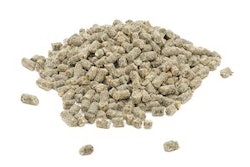
In the post-antibiotic era, low-protein diets are rather the norm than the exception and their benefits are increasingly recognized even when antibiotics are still used in formulations for pigs and poultry. Assuming cost is about the same, feeding low-protein diets (that are fully supplemented with all essential amino acids) can lead to enhanced health and even improved feed efficiency.
Let’s examine each statement in detail to understand why and when low-protein diets can be beneficial from a biological point of view and when this translates to increased profitability.
The role of synthetic amino acids
To begin with, a low-protein diet is one that provides all required amino acids without excesses. Here, we must stress again that a low-protein diet is not meant to be one that does not cover the animal requirements for essential amino acids so that they experience reduced performance. Instead, it is the excess amino acids that are trimmed, and by excess we mean the unavoidable surpluses of all amino acids used to satisfy the need for the first limiting amino acid. The latter refers to lysine for pigs and methionine for poultry (in most conventional corn-soy type diets).
Now, to lower the crude protein concentration of a diet, the use of synthetic amino acids is of paramount importance, and here is where economics should be in favor of the lower-protein diet. As of today, only crystalline lysine, methionine, threonine and tryptophan are commercially available at reasonable prices. As such, we must continue to provide some excess protein in order to cover the needs of other essential amino acids, such as valine and isoleucine.
The question then becomes: how much can we lower crude protein?
The answer is rather easy, but it has taken many years of research to discover. Under most practical conditions, lowering crude protein concentration by two percentage points, by using crystalline amino acids (for example, from 18 to 16 percent crude protein in the diet), creates no problems in animal performance or carcass characteristics.
A reduction of four percentage points requires a bit more work. For this, other amino acids, such as valine and isoleucine must be well balanced by introducing less conventional feedstuffs in to the feed formulation. In addition, all amino acids should be expressed on a digestible basis, whereas the energy of the diet should be expressed using a net energy system (in the case of pigs).
Benefits of low-protein diets
But, let’s get back to why low-protein diets are beneficial. First, the animal benefits from less excess protein (nitrogen) that has to deaminate (detoxify) as free nitrogen in the blood system is toxic and must be excreted (via urine) – and that at a significant energy expenditure.
This brings us to another benefit, namely less urine production and consequently lower demand for water. This translates to less manure volume. In addition, what manure is produced is lower in nitrogen, not only because of less nitrogen in urine, but also because with lower-protein diets, protein digestibility is increased and as such less nitrogen is excreted in fecal matter.
At the end, less land is required needed to dispose the manure, which is a constant headache in many parts of this world.
Utilization of the net energy system
Now, as the animal has less excess protein to get rid off (an energy consuming process), it is left with some spare energy and here we run the risk of increasing carcass lipid concentration if we are not vigilant. This becomes especially tricky as we go from two to four percentage points reduction in dietary crude protein concentration. And, here is where the use of the net energy system is of most importance.
As net energy is expressed independently of dietary crude protein (a problem inherent in the metabolizable energy system that is widely used especially for poultry feeds), we can formulate low-protein diets without increasing carcass fatness. As such, we can take advantage of the energy “surplus” and direct it to productive purposes. This produces improved feed efficiency, which is always a good thing, and, of course, lower cost of production.
In conclusion, low-protein diets are good for the animal, the environment, and the producer. All these assuming the cost of crystalline amino acids does not rob us of all these benefits















